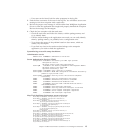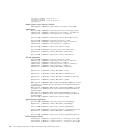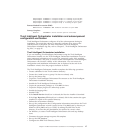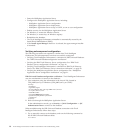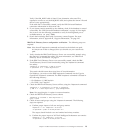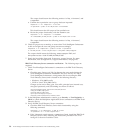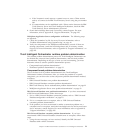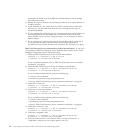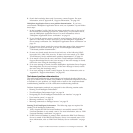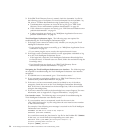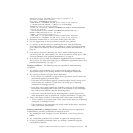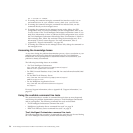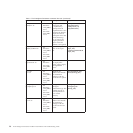8. Search the knowledge bases and, if necessary, contact Support. For more
information, refer to Appendix B, “Support information,” on page 225.
WebSphere
Application Server error problem determination: If you have
encountered a WebSphere Application Server error, use SystemOut.log and follow
these steps:
1. In the SystemOut.log file, find the last startup section by going to the end of
the file and then searching upwards for "End Display". If you cannot find it,
start the WebSphere Application Server. For more information, refer to
“WebSphere Application Server verification” on page 13.
2. If you found the startup section, search for errors between "End Display" and
open for e-business. If errors are found, go to the WebSphere Application
Server startup verification. See “WebSphere Application Server verification” on
page 13.
3. If no errors are found, search for errors at the time stamp of the encountered
problem. If no errors are found, go to the Tivoli Intelligent Orchestrator
“Task-based problem determination.”
4. If errors are found, match the error found with any of the following LDAP
keywords: SEC*, LDAP, LTPA, security. If there is an error match, go to “IBM
Tivoli Directory Server authentication problem determination” on page 22.
5. If no match is found for the error, search the Tivoli Intelligent Orchestrator
Support Knowledge Base for the error message. If the error message is found,
resolve the issue using the knowledge entry.
6. If no error message is found, check the WebSphere Application Server Support
Knowledge Base for the error message. If the error message is found, resolve
the issue using the knowledge entry.
7. If no error message is found, contact Support. For more information, refer to
Appendix B, “Support information,” on page 225.
Task-based problem determination
The task-based troubleshooting methodologies and methods described below can
help you to either solve or isolate your problem to a particular component. To find
a resolution to your problem, you might need to return to the component-based
troubleshooting methods or to the verification troubleshooting methods.
Problem determination methods are proposed for the following runtime tasks:
v “Starting Tivoli Intelligent Orchestrator”
v “Tivoli Intelligent Orchestrator login” on page 24
v “Navigating the Tivoli Intelligent Orchestrator user interface” on page 24
v “User interface errors” on page 24
v “Running workflows” on page 25
v “Running commands on managed servers” on page 25
Starting
Tivoli Intelligent Orchestrator: The following steps are required for
starting Tivoli Intelligent Orchestrator:
1. Verify whether the DB2 Universal Database is successfully started. If DB2
Universal Database is not started, start it. For more information, refer to “DB2
Universal Database verification” on page 10.
2. If DB2 Universal Database is started, check whether the IBM Tivoli Directory
Server is started. If the IBM Tivoli Directory Server is not started, start it. For
more information, refer to “IBM Tivoli Directory Server verification” on page
11.
Chapter 2. Problem determination essentials for Tivoli Intelligent Orchestrator 23



